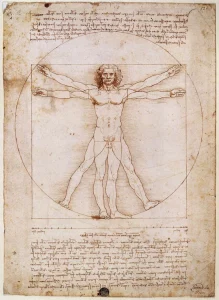A ‘normal’ human being (with CKD)
People with CKD are normal human beings. They happen to have a long-term kidney disease. But what do normal human beings with and without CKD look like? What are their physiological variables? We will explain in this article.
Back to the Renaissance.
An ideal perfect man, with perfect classical proportions, according to Leonardo Da Vinci looked like this:

This drawing is called Vitruvian man. It’s how Da Vinci represented on a classical Roman ideal (of a ‘perfect man’) that included:
- The umbilicus at half of the man’s height
- Arms and legs shown in 2 positions reaching the edge of a square or circle.
But in reality there is no such this as a perfect man, or a ‘normal human being’, as there is such a wide range of normality.
Average normal human physiological variables
- Blood pressure (BP): 120/70
- Pulse (heart) rate: 80 beats per minute
- Breathing (respiratory rate): 16 breaths per minute
- Temperature (core): 37°C
- Blood pH (acid-base balance): 7.40.
Normal physiological variable ranges
- Blood pressure (BP): between 90/60 mmHg and 130/80 mmHg
- Pulse (heart) rate: 60 to 100 beats per minute
- Breathing (respiratory rate): 12 to 20 breaths per minute
- Temperature (core): average 37°C (36.5°C to 37.3°C)
- Blood pH (acid-base balance): pH range 7.35 to 7.45, with the average of 7.40.
Of course, these biomedical variables are also not true (anything in medicine or science that is ‘too neat’ is rarely true). They are just currently accepted normal ranges, for most people, most of the time.
In other words, there will be plenty of normal well people with:
- A BP of 145/95
- A pulse rate of 40 bpm and
- A core temperature of 35.7 C.
And these people do not have a disease.
This is because they are biomedical variables that follow a Normal (or Gaussian) distribution, like weight or height – as shown in the following graph. And people who are 154cm and 196 cm (3 SDs from the mean) are not ill. That graph would be the same shape (with the same inferences) for blood pressure, heart or respiratory rate, temperature and pH.
:max_bytes(150000):strip_icc()/HtsEmpirical-1-d8d33ce1b8a64870a8cd0d67f1d8bf0d.png)
So what does a person with CKD look like, from a physiological point of view?
They could have the following physiological (biomedical) variables:
- Blood pressure (BP): 150/90. High blood pressure is very common in CKD
- Pulse (heart) rate (HR): 50 or 100 beats per minute, depending on medication. Blood pressure tablets often affect heart rate, e.g. Bisoprolol will lower HR, and Amlodipine increase it
- Breathing (respiratory rate): 20 breaths per minute. This can be more when fluid overloaded and there is pulmonary oedema (fluid in the lungs)
- Temperature (core): 36°C. Temperature is usually normal, but patients with more advanced CKD feel cold alot of the time, whatever the season. The reason is unclear.
- Blood pH (acid-base balance): 7.32. Mild acidosis (raised acid levels in the blood) is a feature of CKD, as the kidneys cannot get rid of acid properly.
Summary
A normal human being (with CKD) is well, normal. But their physiological variables are often abnormal, in the way described above. If they are on the correct medication, most of these variables will come back to normal. This is an important way that doctors know that a patient’s CKD is under control (not just creatinine and GFR). We hope this has been helpful.
Other resources
Last Reviewed on 23 September 2024
